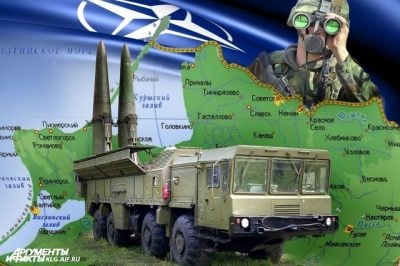Russia Deploys Missiles on Its Own Territory, NATO Goes Ballistic

Over the past few days, the “dispute” between NATO and Russia over the latter’s deployment of Iskander-M rockets in its own Kaliningrad region has heated up. In particular, on February 14th, NATO Secretary General Jens Stoltenberg urged Russia to be “transparent,” although he also admitted that Moscow had announced its missile deployments to its border region a few years ago. In other words, Stoltenberg’s recent statement on the matter bore no semblance of transparency.
Meanwhile, Russia is working to make this “issue” a transparent one. I believe it to be no coincidence that on last Sunday, February 11th, the popular program Voennaia priomka on the Zvezda TV channel of Russia’s Ministry of Defense, discussed in detail the tactical and technical characteristics of Iskander missile complexes.
The real cause of NATO’s concern is not “transparency”, but the combat capabilities of Russia’s Iskanders and the political will to use them. Indeed, the putting of Iskanders in Kaliningrad on alert bears serious implications for the military and political situation in the Baltic region.
On February 5th, Russia deployed Iskander-M operative-tactical rocket complexes near Kaliningrad. These “OTRC’s” are designed to destroy an opponent’s reactive volley fire systems, anti-missile hardware, air defenses, aircraft and helicopters at airfields, command posts, and infrastructural facilities. One OTRC Iskander-M is capable of hitting targets at ranges of up to 500 kilometers with two types of missiles – ballistic and cruise.
It is obviously not spoken above a whisper, but the implied, hypothetical, main target of these Iskanders – if things reach this point – would the American missile defense systems in Eastern Europe that have been installed under the pretext of “defending against Iranian missiles.”
In Romania, the Aegis US missile defense complex is already open and kept on combat readiness. In May 2016, the construction of an improved Aegis ground-system began in the Polish town of Redzikowo near the Baltic coast (150 kilometers from Gdansk), which is set to be ready in 2018.
Already during the initial phase of building these missile bases in Romania, Russia military experts argued that these systems would target Russian tactical rockets and other high-precision weapons. This is explained by the fact that the launch systems installed in Romania (and soon Poland) can launch not only missile defense system rockets, but also cruise missiles capable of striking strategic targets in western and central Russia.
As the Russian foreign ministry has stated since the very beginning, the US’ decision to establish missile systems on Romanian territory violates the balance of strategic forces in Europe and contradicts the provisions of the treaty on intermediate and short-range missiles.
But Moscow’s objections have not been heeded. Nor have Russia’s promises to prepare to “respond” to American missile systems in Romania and Poland been heard. The deployment of Iskanders in the Kaliningrad region is presumably one demonstrative element of this response.
Another possible step might be the use of the latest Kalibr cruise missiles which the surface ships and submarines of the Russian Batlic Fleet are equipped with, and which have a range of 2,500 kilometers. Kalibr production could be accelerated for deployment in the Baltic, but this is already from the realm of proposals.
The political component of the dispute over Russia’s Iskanders is no less important. On February 15th followed verbal responses from Russian parliamentarians from the State Duma and Federation Council. For instance, in an interview with RT, the deputy chairman of the Federation Council’s Committee on International Affairs, Andrey Klimov, stressed:
“Iskanders have been placed there [in the Kaliningrad region] due to the fact that NATO is expanding its military activity near our borders…We, it is worth noting, are doing this on our own sovereign land. That is the most important point. The US’ missile defense systems are deployed far from their borders. And a troop contingent is surrounding Russia’s entire perimeter.”
We can add to this Russian senator’s comment that just the other day it came to light that the US budget for 2019 provisions $6.3 billion for “deterring Russia in Europe by military means.” The plan envisages an increase in American troop presence in EU countries, training NATO forces in Eastern Europe, and modernizing US military equipment stationed in the EU.
The “Iskander controversy” is thus an attack on Russia’s right to defend itself. Without a doubt, both sides – Russia and NATO – will not abandon their positions, which does not facilitate peace in Europe. The main losers of any possibly impending conflict can already be named: Poland and Romania, as they have become number one targets for Russian retaliatory missile strikes. Overall, NATO is turning Eastern Europe into a risk zone, and Russia intends to defend itself. This is the real meaning behind the “Iskander controversy.”
*
Translated by Jafe Arnold
Eduard Popov is a Rostov State University graduate with a PhD in history and philosophy. In 2008, he founded the Center for Ukrainian Studies of the Southern Federal University of Russia, and from 2009-2013, he was the founding head of the Black Sea-Caspian Center of the Russian Institute for Strategic Studies, an analytical institute of the Presidential Administration of Russia.
Featured image is from the author.

